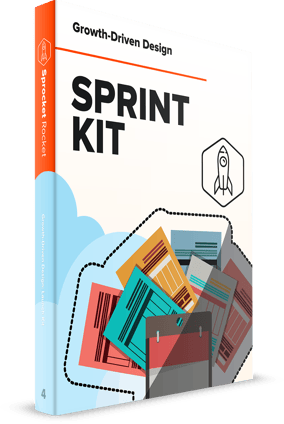Create a Free Account
Sprint Kit

Chapters
Why Do Agile Teams Run Sprints?
Launch More Frequently
Data-Driven Approach
Time Boxing Increases Momentum
Repeatable / Scalable Work Model
How to use this Sprint Kit
The team at Lean Labs & Sprocket Rocket use this sprint kit to plan and organize our lean sprints for all of our Growth Driven Design clients.
We’ll break down the key elements of a successful sprint into easy steps that your team can use to plan effective sprints.
Screenshots shown are from our tools Growth Hackers Projects & Liquid Planner, but they are not required to run agile sprints. You can do similar work with Trello and/or this template.
Set a Clear Focus Objective

Your growth team won’t be able to show significant results unless your actions are focused on a single goal.
We ask our clients to set a quarterly growth objective as the first step in preparing for sprints. The growth objective should be “SMART:” specific, measurable, achievable, results-focused, and time-bound.
The image above shows an example of a growth objective. You may set a goal by sprint, month, or quarter. We have found that by month is best.
Gather & Prioritize Ideas

You don’t want to just run with every idea your team suggests. Regardless of who submits the idea, each suggestion should be scored for an “ICE” rating.
ICE = [Impact + Confidence + Ease / 3]
The image above shows ideas, sorted by their ICE rating.
Develop a Test Plan
Budget & Time Box Sprints
Your growth team should operate on a budget and a time limit for each test.
Depending on the size of your team and the amount of traffic you have to test with, tests may last from days to weeks.
We run two week sprints, but a sprint can be from one week to one month.
The following slides will offer broad tips for
budgeting and time boxing continuous improvement sprints.

Budgeting for Sprints
Simple: Budget In Hours
If you manage the “should take” and “could take” hours for each task in the sprint, you can total the required effort to complete the sprint as well as individual team workloads.
Set a monthly budget of 25 hours, 50 hours, or 75 hours (based upon your team size and budget of course).
Lean: Budget In Points
You may find that hour estimates are regularly wrong. Women tend to estimate 15% low and men 40%. Using points is one way that agile teams estimate more effectively.
Using the Fibonacci sequence (1, 2, 3, 5, 8, 13, 21), teams roll their quick hours estimate up to the closest “point value” to more rapidly (and more accurately) estimate the energy for tasks.

Estimating Skills
By comparing the actual energy required to complete a project to the estimated effort, your team can get better at estimating its efforts over time.

Time Boxing Sprints
You’ll want to deliver everything you promise on time. As such, only put tasks into a sprint that can be completed in the allotted time period. Roll other work to the next sprint. It’s imperative to start & end a sprint on time to avoid a “traditional” workflow that will always run late, as pictured below in a burndown chart
Build a High-Conversion Website on HubSpot
Make Daily Accountability Charts

Whether your team runs a SCRUM process or not, each day your growth team should execute on high-value efforts towards completing the sprint.
We suggest using ¾ of the day towards key efforts.
By planning your week in advance and giving each task, a completion day, your team becomes accountable to daily progress, which drives action.
Trello is a great tool for this type of planning, but even a spreadsheet can work.
Measure & Report Results

Whether you use HubSpot Reporting, Databox, or a spreadsheet, each sprint’s efforts should be tracked against larger quarterly and annual growth goals.
Optimization is practice stacking small wins atop each other and letting the compounding effect deliver valuable results for the organization.
Maintain a Sprint Rhythm
From Ideation to Creation in Minutes
We took all of the efficiencies we’ve gained in developing HubSpot COS websites for over four years and created a new design system called Sprocket Rocket.
This design system enables brands and agencies to build an 8/10 website with a 3/10 budget, without cutting out critical components like strategy, content creation, and custom design.
©2026 Brandvious, Inc. All rights reserved. Privacy Policy | Terms of Service


